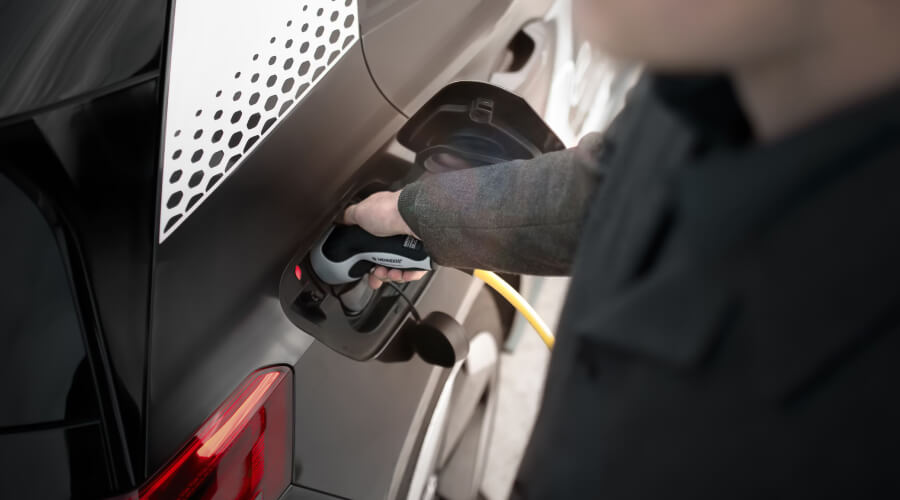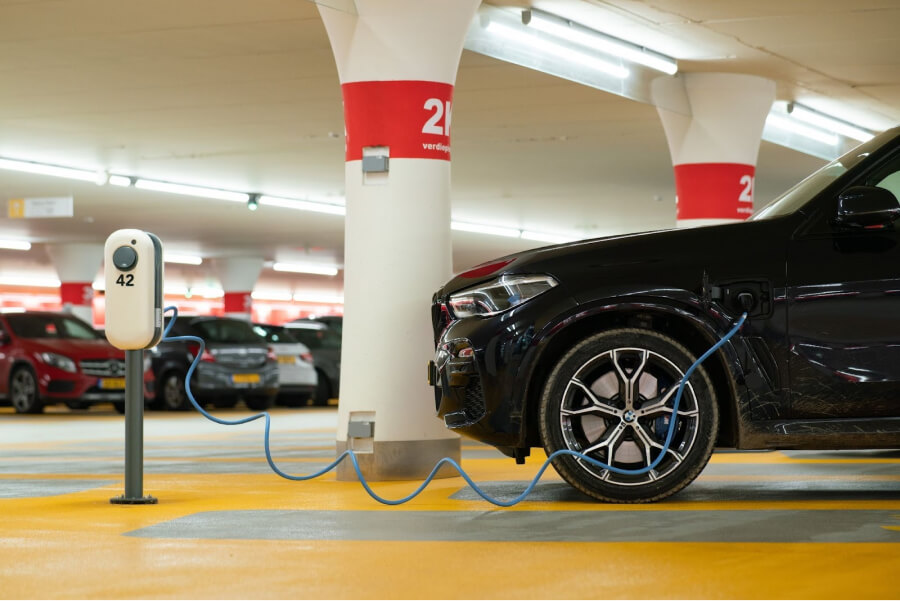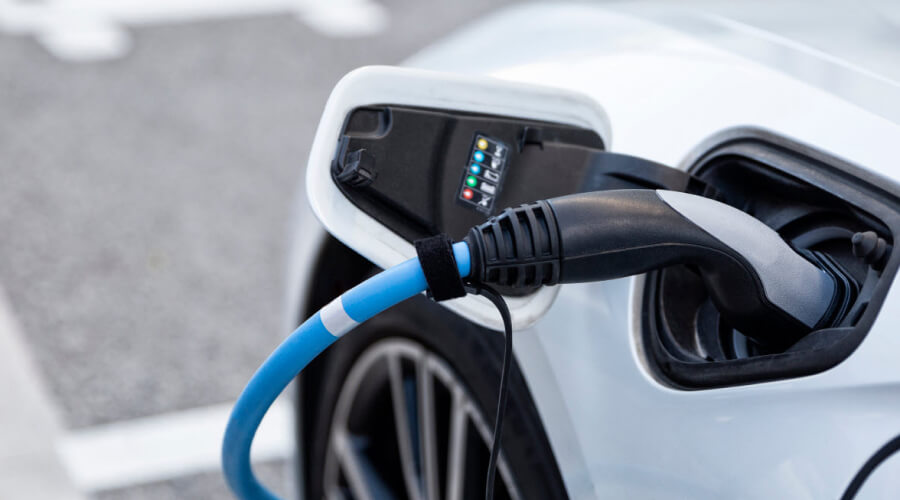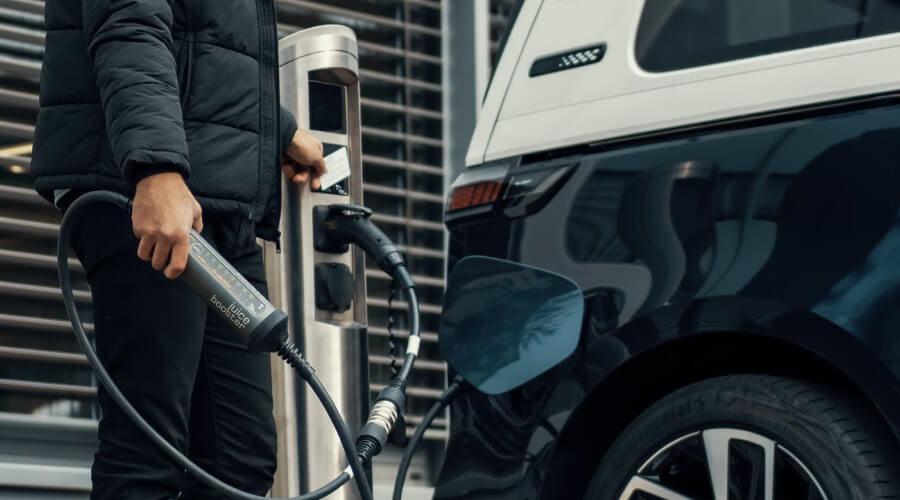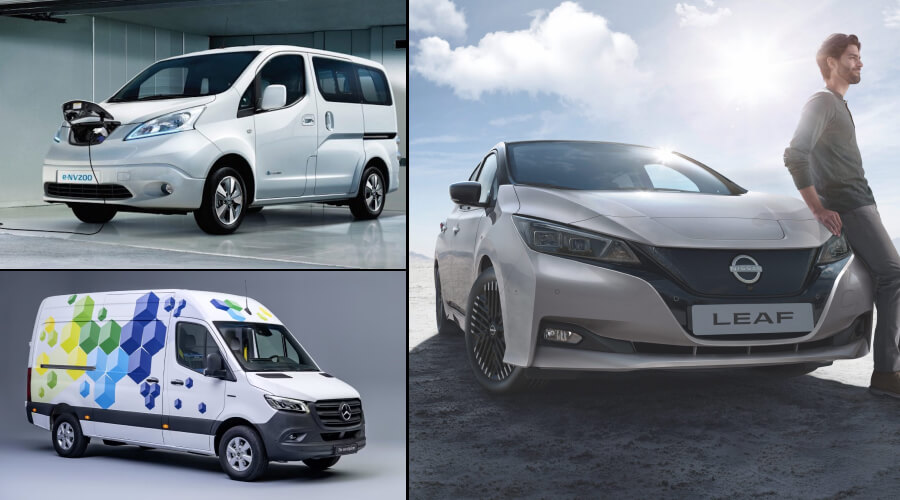In this guide, we’ll look at all your charging options to keep your fleet charged while on the road.
Finding Public EV Charging Stations
- In-Built Station Finder: Most EVs will come with a map built into the system to tell you where the nearest charging station is.
- PlugShare: PlugShare, available online and via its app, helps locate charging stations based on your location and EV plug type. You can also filter by charging networks.
- Google Maps: If you type EV Charging Station into Google Maps, you’ll be able to see a range of stations nearby.
How To Charge Your EV on the Road
Australia boasts an expanding network of EV charging stations, from highways to city landmarks like the Melbourne Zoo and Queen Victoria Market.
While many stations are cable-free for security, always carry a compatible lead and a standard Australian power point cable for emergencies.
Tip
Step-by-Step Guide to Charging Your EV on the Go
- Preparation: Ensure you have your charging cable and a compatible adapter in your vehicle.
- Plan Your Route: Use apps like Plugshare to identify the fastest charging stations along your intended journey.
- Approach & Park: Once you reach a charging station, position your EV so the charging port is close to the unit.
- Connect: If the station has a tethered cable, connect it to your EV. If not, use your vehicle’s charging cable.
- Initiate Charging: Follow on-screen prompts or app instructions. Some stations might require payment or authentication via RFID cards or apps.
- Monitor: Keep an eye on the charging process. Many apps will notify you once charging is complete or if there are any interruptions.
- Wrap Up: Once charged, disconnect the charger, safely store your cable and adapter, and ensure you’ve concluded any payment or app session.
- Emergency Charging: In case of unforeseen situations where standard charging stations aren’t available, look for a standard powerpoint to charge your EV, albeit at a slower pace.
Fuel Stations with EV Chargers
Australia’s automotive scene is rapidly changing with the rise of EVs. As fuel stations adapt, long-distance EV journeys become easier.
Which Stations Support EV Charging?
About 370 fuel stations nationwide support EV charging
Across Australia, fuel stations are slowly integrating EV charging facilities. At the time of writing, here are the fuel networks that have started to set up EV chargers on-site:
- BP (bp pulse)
- Ampol (AmpCharge)
The New ‘Fuel’ Stations
While traditional fuel stations catch up, various networks have been established to offer public charging services:
- bp EV charging
- bp pulse Australia
- ChargeNet
- ChargePoint
- Evie Networks
- EVUp
- Exploren
- JOLT
- Shell Sky EV Technology
- Supercharger (Tesla)
- Tesla Destination Charging
You’ll also find public charging stations at various local shops, public car parks and community centres.
Which Stations Have EV Charge Cards for Business?
At the time of writing, 0 stations offer EV Charge Cards for business
While the concept of fuel cards is a familiar one in the world of traditional fuel networks, the transition to EV charge cards in Australia is still in its infancy.
We reached out to various fuel networks to gauge their stance on offering their own version of EV charge cards.
Interestingly, none of them indicated current plans to integrate EV Charge Cards into their offerings.
However, looking at overseas markets where EV Charge Cards have gained traction, it seems inevitable that Australian fuel companies will soon embrace this trend.
Cost of EV Charging
Charging your EV at public stations costs about $40
Recharging an EV is more cost-effective than refuelling a traditional petrol or diesel vehicle. However, the actual cost can vary based on factors like your electricity rates, the charging station’s pricing, and your EV model.
- A full charge at a public EV station costs about $40.
- This is about 25c per kWh
- Keep in mind the average person drives about 35 km per day
How does this compare to fuel prices?
- Say your car’s efficiency is 8.7L/100KM.
- At the cost of fuel at $2.10 per litre, you’ll pay 18.27 cents per kilometre.
- To fill up a tank (if your car has, say, 60L) would cost you $126.
This is more than 3x as much as charging your EV.
Psssst: Charging your EV at home could be more cost-effective, particularly if you’re tapping into green energy from a solar setup.
For a better estimate, you can use JET Charge’s EV charging cost calculator.
How Long Does EV Charging Take at Public Stations?
On average, from 0-80%, roughly 1 hour
Most public charging stations will offer up to 11kW AC or 50kW DC charging speeds. You’ll typically find these in shopping car parks, workplaces, and other public spaces. There are also rapid charging stations that can offer up to 350kW DC to compatible vehicles.
Charging time estimates for a 75 kWh battery (from empty to 80% or 60 kWh)
- 11kW AC – 5 hours and 27 minutes
- 50kW DC – 1 hour and 12 minutes
- 350kW DC – 10 minutes
However, the time it takes to recharge your EV at public stations isn’t one-size-fits-all. Several factors play a role in determining the speed:
- Charger Type: EVs use AC (slower) or DC (faster) chargers.
- Charger Power: Public stations range from ‘fast’ to ‘ultra-rapid’, while home chargers tend to be slower.
- Vehicle’s Electricity Intake: Models like the Hyundai IONIQ 5 and Porsche Taycan charge quicker than others.
- Battery Charge Status: Charging up to 80% is recommended for battery longevity, and speed decreases as the battery fills.
- Environmental Factors: Extreme temperatures can impact charging efficiency.
Is Charging Your EV on the Road Worth it?
Charging your EV at home is ideal, but Australia’s robust infrastructure ensures you’re covered on the road too. Home or highway, you’re powered up!
EV Charging on the Road FAQs
Where can I get free EV charging in Australia?
In Australia, NRMA provides free EV charging for everyone, though non-members might pay in the future. JOLT gives free daily charging up to 7 kWh and partners with Endeavour Energy for free charging in Sydney. Meanwhile, Pepper Money-Evie Networks collaboration gifts a 12-month free charge (up to 2,000 kWh) for eligible EV loan holders. While various providers offer freebies, always be prepared for changing terms and potential costs down the line.
What is the difference between public and private EV charging stations?
The primary differences between public and private EV charging stations are accessibility, charging speeds, and costs:
- Accessibility:
- Public: Found at shopping centres, highways, and public car parks.
- Private: Located at homes or businesses for personal or company use.
- Charging Speeds:
- Public: Typically faster or ultra-rapid for quick charges on the go.
- Private: Slower, Level 1 or Level 2, ideal for overnight charging.
- Costs:
- Public: Usually fee-based, with occasional free promotional offers.
- Private: No direct fee, but homeowners see costs in their electricity bill.
What plug do you need for public EV charging?
For public EV charging in Australia, the plug you’ll need largely depends on the make and model of your electric vehicle, as well as the charging station you’re using. Here are the primary plug types that you’ll encounter at public EV charging stations:
- Type 1 (J1772 or SAE J1772):
Commonly used in North America and Japan, this plug type supports single-phase AC charging. In Australia, it’s found on some Mitsubishi EVs and a few older model EVs. - Type 2 (IEC 62196 or Mennekes):
This is the standard plug type for Australian and European EVs. It’s a seven-pin design that supports single-phase and three-phase AC charging. Most new EVs in Australia use this plug. - CHAdeMO:
This DC fast-charging plug type is used predominantly by Japanese car brands like Nissan, Mitsubishi, and Toyota, but also by some European brands. It provides rapid charging capabilities, especially beneficial for longer journeys. - CCS (Combined Charging System):
This fast-charging plug allows both AC and DC charging using the same port. There are two versions: CCS1 (for Type 1 connections) and CCS2 (for Type 2 connections). Many modern EVs in Australia, such as the Hyundai IONIQ 5 and Kia EV6, come with a CCS2 port, allowing for both regular home charging and fast public charging. - Tesla Supercharger:
These plugs are designed exclusively for Tesla vehicles. Although similar in design to the Type 2 plug, they support much faster DC charging rates. Note that in Australia, some Tesla vehicles come with a modified Type 2 port for AC charging. - Tesla Destination Plug:
While similar to the Supercharger, these are designed for slower charging at destinations like hotels and restaurants.

